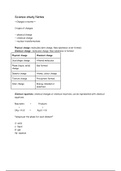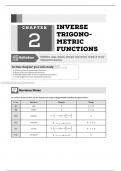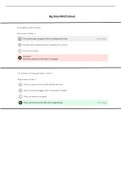2023-2024, Block 5 GW4009MV. Healthcare Procurement & Value Chain Management
HPVCM Literature
Contents
Literature 14 & 15.............................................................................................................................................3
For lecture 1:................................................................................................................................................3
I. Kraljic (1983). Purchasing must become Supply Management..............................................................3
Supply Strategy.....................................................................................................................................3
4-stage approach to shape supply strategies........................................................................................4
II. Lichtenberger et al. (2010). How sourcing excellence can lower hospital costs...................................8
Sourcing Excellence – 3 phases of evolution.........................................................................................8
Sourcing Excellence – 3 organizational enablers.................................................................................10
III. Prada (2016). Value-based procurement: Canada’s healthcare imperative.......................................11
Value beyond cost savings..................................................................................................................11
Implementation of value-based procurement....................................................................................12
For workshop 1:..........................................................................................................................................13
IV. Van Ginneken (2015). Perennial Health Care Reform – The Long Dutch Quest for Cost Control &
Quality Improvement..............................................................................................................................13
For lecture 2:..............................................................................................................................................14
V. Robinson (2008). Value-Based Purchasing for Medical Devices.........................................................14
Value-Based Purchasing (VBP)............................................................................................................14
VI. Den Ambtman et al. (2020). Analysing actual prices of medical products – a cross-sectional survey
of Dutch hospitals...................................................................................................................................17
VII. Stanberry et al. (2021). Using the MEAT VBP Framework to analyse and understand the value of
surgical gloves: an explanatory case study.............................................................................................19
Value-Based Procurement Models......................................................................................................19
The Cost, Quality and Outcomes (CQO) Movement........................................................................20
The MEAT Value-Based Procurement (VBP) Framework.................................................................20
Literature Week 16.........................................................................................................................................24
For workshop 2:..........................................................................................................................................24
VIII. Arrowsmith et al. (2011) – Chapter 1: Public Procurement: Basic Concepts and the Coverage of
Procurement Rules.................................................................................................................................24
Public procurement objectives...............................................................................................................25
Key principles for implementing procurement objectives: transparency, competition & equal
treatment............................................................................................................................................26
For lecture 3:..............................................................................................................................................30
IX. Cattel et al. (2018). Value-based provider payment: towards a theoretically preferred design........30
1
,2023-2024, Block 5 GW4009MV. Healthcare Procurement & Value Chain Management
Key-value dimensions in healthcare....................................................................................................31
A theoretically preferred VBP design..................................................................................................32
X. Van Veghel et al. (2018). Health insurance outcome-based purchasing.............................................36
An innovative VBHC-aligned outcome-based payment model............................................................37
XI. Porter & Kaplan (2016). How to pay for health care..........................................................................39
How fee-for-service destroys value for patients..................................................................................39
Capitation / Population-based payment.............................................................................................39
Bundled payments..............................................................................................................................40
Literature Week 17.........................................................................................................................................44
For workshop 3:..........................................................................................................................................44
XII. Duran et al. (2005) – Chapter 9: Purchasers, providers and contracts..............................................44
Types of Contracts...............................................................................................................................44
The contracting process......................................................................................................................48
SUMMARY & CONCLUSIONS...............................................................................................................49
For lecture 4:..............................................................................................................................................51
XIII. Hinrichs-Krapels et al. (2022). Towards sustainability for medical devices and consumables.........51
XIV. Maarse & Jeurissen (2024). Healthcare reform in the NL: after 15yrs of regulated competition.. .52
The impact of the reform....................................................................................................................52
A more hybrid system.........................................................................................................................55
Literature Week 18.........................................................................................................................................57
For workshop 4:..........................................................................................................................................57
Van Weele (2010). The 6-stage purchasing maturity/developmental model. NO EXAM MATERIAL .....57
For lecture 5:..............................................................................................................................................59
XV. Dyer & Singh (1998). The Relational view: cooperative strategy and sources of interorganizational
competitive advantage...........................................................................................................................59
Competitive advantages of relational rents/partnerships...................................................................59
XVI. Frydlinger et al. (2019). A New Approach to Contracts: how to build better long-term strategic
partnerships............................................................................................................................................63
Vested approach.................................................................................................................................63
5-step process to implement the vested methodology:......................................................................64
The 6 guiding principles..................................................................................................................64
2
,2023-2024, Block 5 GW4009MV. Healthcare Procurement & Value Chain Management
Literature 14 & 15
For lecture 1:
I. Kraljic (1983). Purchasing must become Supply Management.
To ensure long-term availability of critical materials and components at competitive cost, a host of
manufacturers will have to come to grips with the risks and complexities of global sourcing. Others that
already source on a global basis must learn to cope with uncertainties and supply or price disruptions on an
unprecedented scale. Instead of simply monitoring current developments, management must learn to
make things happen to its own advantage. This calls for nothing less than a total change of perspective:
from purchasing (an operating function) to supply management (a strategic one).
The greater the uncertainty of supplier relationships, technological developments, and/or physical
availability of those items, the more important supply management becomes.
Supply Strategy
DIAGNOSING THE CASE
A company’s need for a supply strategy depends on 2 factors: ( See Exhibit I)
o The strategic importance of purchasing in terms of the value added by product line, the
percentage of raw materials in total costs and their impact on profitability.
o The complexity of the supply market gauged by supply scarcity, pace of technology and/or
materials substitution, entry barriers, logistics cost or complexity, and monopoly or oligopoly
conditions.
By assessing the company’s situation on both, managers and purchasers can determine the type of supply
strategy needed to exploit its purchasing power vis-à-vis (= tegenover) important suppliers and to reduce
its risks to an acceptable minimum. Assessment should explore questions like these:
1) Is the company making good use of opportunities for concerted action among different divisions
and/or subsidiaries? Combining supply requirements of different divisions can increase the
corporation’s total buying clout.
2) Can the company avoid anticipated supply bottlenecks and interruptions? Knowing where and
why bottlenecks occur, actions can be taken to solve the problem.
3) How much risk is acceptable? Vendor mix, extent of contractual coverage, regional spread of
supply sources, and availability of scarce materials all contribute to the company’s supply risk
profile. A company can often take action to lessen unacceptable risk.
4) What make-or-buy policies will give the best balance between cost and flexibility? If the company
covers a large percentage of its supplies from sources it owns, it will be in a much better
negotiating position to cover the remainder of its outside requirements than its less-integrated
competitors. On the other hand, the company may find it more profitable to source outside if key
suppliers have chronic overcapacity.
5) To what extent might cooperation with suppliers or even competitors strengthen long-term
supply relationships or capitalize on shared resources? Involving suppliers early in the design
process can ensure better quality, lower cost, and “just in time” production.
3
, 2023-2024, Block 5 GW4009MV. Healthcare Procurement & Value Chain Management
4-stage approach to shape supply strategies
SHAPING THE SUPPLY STRATEGY
To minimize their supply vulnerabilities and make the most of their potential buying power, a number of
European companies have successfully used a four-stage approach to devise strategies. It provides a simple
but effective framework for collecting marketing and corporate data, forecasting future supply scenarios,
and identifying available purchasing options as well as for developing individual supply strategies for critical
items and materials.
1) Phase 1: Classification. First all the company’s purchased materials or components are classified in
terms of profit impact and supply risk.
The profit impact of a given supply item can be defined in terms of: the volume purchased, percentage
of total purchase cost, or impact on product quality or business growth.
Supply risk is assessed in terms of: availability, number of suppliers, competitive demand, make-or-buy
opportunities, and storage risks and substitution possibilities.
4
HPVCM Literature
Contents
Literature 14 & 15.............................................................................................................................................3
For lecture 1:................................................................................................................................................3
I. Kraljic (1983). Purchasing must become Supply Management..............................................................3
Supply Strategy.....................................................................................................................................3
4-stage approach to shape supply strategies........................................................................................4
II. Lichtenberger et al. (2010). How sourcing excellence can lower hospital costs...................................8
Sourcing Excellence – 3 phases of evolution.........................................................................................8
Sourcing Excellence – 3 organizational enablers.................................................................................10
III. Prada (2016). Value-based procurement: Canada’s healthcare imperative.......................................11
Value beyond cost savings..................................................................................................................11
Implementation of value-based procurement....................................................................................12
For workshop 1:..........................................................................................................................................13
IV. Van Ginneken (2015). Perennial Health Care Reform – The Long Dutch Quest for Cost Control &
Quality Improvement..............................................................................................................................13
For lecture 2:..............................................................................................................................................14
V. Robinson (2008). Value-Based Purchasing for Medical Devices.........................................................14
Value-Based Purchasing (VBP)............................................................................................................14
VI. Den Ambtman et al. (2020). Analysing actual prices of medical products – a cross-sectional survey
of Dutch hospitals...................................................................................................................................17
VII. Stanberry et al. (2021). Using the MEAT VBP Framework to analyse and understand the value of
surgical gloves: an explanatory case study.............................................................................................19
Value-Based Procurement Models......................................................................................................19
The Cost, Quality and Outcomes (CQO) Movement........................................................................20
The MEAT Value-Based Procurement (VBP) Framework.................................................................20
Literature Week 16.........................................................................................................................................24
For workshop 2:..........................................................................................................................................24
VIII. Arrowsmith et al. (2011) – Chapter 1: Public Procurement: Basic Concepts and the Coverage of
Procurement Rules.................................................................................................................................24
Public procurement objectives...............................................................................................................25
Key principles for implementing procurement objectives: transparency, competition & equal
treatment............................................................................................................................................26
For lecture 3:..............................................................................................................................................30
IX. Cattel et al. (2018). Value-based provider payment: towards a theoretically preferred design........30
1
,2023-2024, Block 5 GW4009MV. Healthcare Procurement & Value Chain Management
Key-value dimensions in healthcare....................................................................................................31
A theoretically preferred VBP design..................................................................................................32
X. Van Veghel et al. (2018). Health insurance outcome-based purchasing.............................................36
An innovative VBHC-aligned outcome-based payment model............................................................37
XI. Porter & Kaplan (2016). How to pay for health care..........................................................................39
How fee-for-service destroys value for patients..................................................................................39
Capitation / Population-based payment.............................................................................................39
Bundled payments..............................................................................................................................40
Literature Week 17.........................................................................................................................................44
For workshop 3:..........................................................................................................................................44
XII. Duran et al. (2005) – Chapter 9: Purchasers, providers and contracts..............................................44
Types of Contracts...............................................................................................................................44
The contracting process......................................................................................................................48
SUMMARY & CONCLUSIONS...............................................................................................................49
For lecture 4:..............................................................................................................................................51
XIII. Hinrichs-Krapels et al. (2022). Towards sustainability for medical devices and consumables.........51
XIV. Maarse & Jeurissen (2024). Healthcare reform in the NL: after 15yrs of regulated competition.. .52
The impact of the reform....................................................................................................................52
A more hybrid system.........................................................................................................................55
Literature Week 18.........................................................................................................................................57
For workshop 4:..........................................................................................................................................57
Van Weele (2010). The 6-stage purchasing maturity/developmental model. NO EXAM MATERIAL .....57
For lecture 5:..............................................................................................................................................59
XV. Dyer & Singh (1998). The Relational view: cooperative strategy and sources of interorganizational
competitive advantage...........................................................................................................................59
Competitive advantages of relational rents/partnerships...................................................................59
XVI. Frydlinger et al. (2019). A New Approach to Contracts: how to build better long-term strategic
partnerships............................................................................................................................................63
Vested approach.................................................................................................................................63
5-step process to implement the vested methodology:......................................................................64
The 6 guiding principles..................................................................................................................64
2
,2023-2024, Block 5 GW4009MV. Healthcare Procurement & Value Chain Management
Literature 14 & 15
For lecture 1:
I. Kraljic (1983). Purchasing must become Supply Management.
To ensure long-term availability of critical materials and components at competitive cost, a host of
manufacturers will have to come to grips with the risks and complexities of global sourcing. Others that
already source on a global basis must learn to cope with uncertainties and supply or price disruptions on an
unprecedented scale. Instead of simply monitoring current developments, management must learn to
make things happen to its own advantage. This calls for nothing less than a total change of perspective:
from purchasing (an operating function) to supply management (a strategic one).
The greater the uncertainty of supplier relationships, technological developments, and/or physical
availability of those items, the more important supply management becomes.
Supply Strategy
DIAGNOSING THE CASE
A company’s need for a supply strategy depends on 2 factors: ( See Exhibit I)
o The strategic importance of purchasing in terms of the value added by product line, the
percentage of raw materials in total costs and their impact on profitability.
o The complexity of the supply market gauged by supply scarcity, pace of technology and/or
materials substitution, entry barriers, logistics cost or complexity, and monopoly or oligopoly
conditions.
By assessing the company’s situation on both, managers and purchasers can determine the type of supply
strategy needed to exploit its purchasing power vis-à-vis (= tegenover) important suppliers and to reduce
its risks to an acceptable minimum. Assessment should explore questions like these:
1) Is the company making good use of opportunities for concerted action among different divisions
and/or subsidiaries? Combining supply requirements of different divisions can increase the
corporation’s total buying clout.
2) Can the company avoid anticipated supply bottlenecks and interruptions? Knowing where and
why bottlenecks occur, actions can be taken to solve the problem.
3) How much risk is acceptable? Vendor mix, extent of contractual coverage, regional spread of
supply sources, and availability of scarce materials all contribute to the company’s supply risk
profile. A company can often take action to lessen unacceptable risk.
4) What make-or-buy policies will give the best balance between cost and flexibility? If the company
covers a large percentage of its supplies from sources it owns, it will be in a much better
negotiating position to cover the remainder of its outside requirements than its less-integrated
competitors. On the other hand, the company may find it more profitable to source outside if key
suppliers have chronic overcapacity.
5) To what extent might cooperation with suppliers or even competitors strengthen long-term
supply relationships or capitalize on shared resources? Involving suppliers early in the design
process can ensure better quality, lower cost, and “just in time” production.
3
, 2023-2024, Block 5 GW4009MV. Healthcare Procurement & Value Chain Management
4-stage approach to shape supply strategies
SHAPING THE SUPPLY STRATEGY
To minimize their supply vulnerabilities and make the most of their potential buying power, a number of
European companies have successfully used a four-stage approach to devise strategies. It provides a simple
but effective framework for collecting marketing and corporate data, forecasting future supply scenarios,
and identifying available purchasing options as well as for developing individual supply strategies for critical
items and materials.
1) Phase 1: Classification. First all the company’s purchased materials or components are classified in
terms of profit impact and supply risk.
The profit impact of a given supply item can be defined in terms of: the volume purchased, percentage
of total purchase cost, or impact on product quality or business growth.
Supply risk is assessed in terms of: availability, number of suppliers, competitive demand, make-or-buy
opportunities, and storage risks and substitution possibilities.
4










